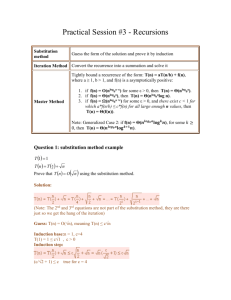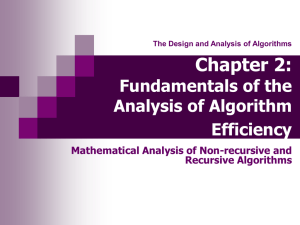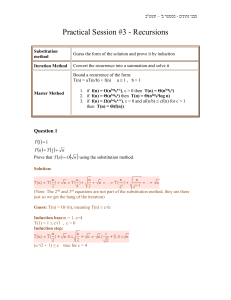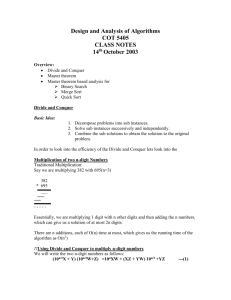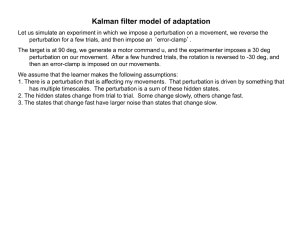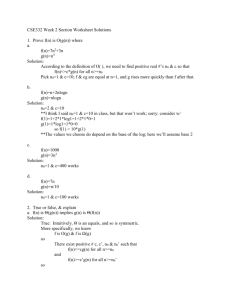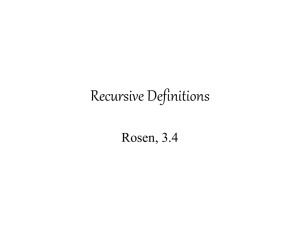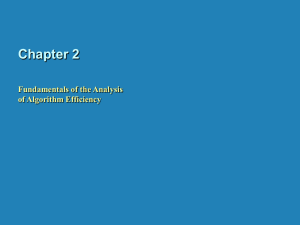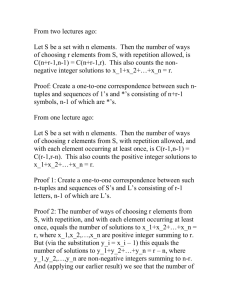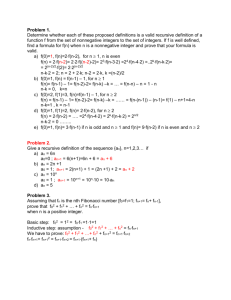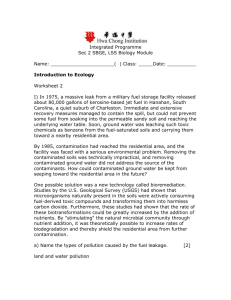Substitution method
advertisement
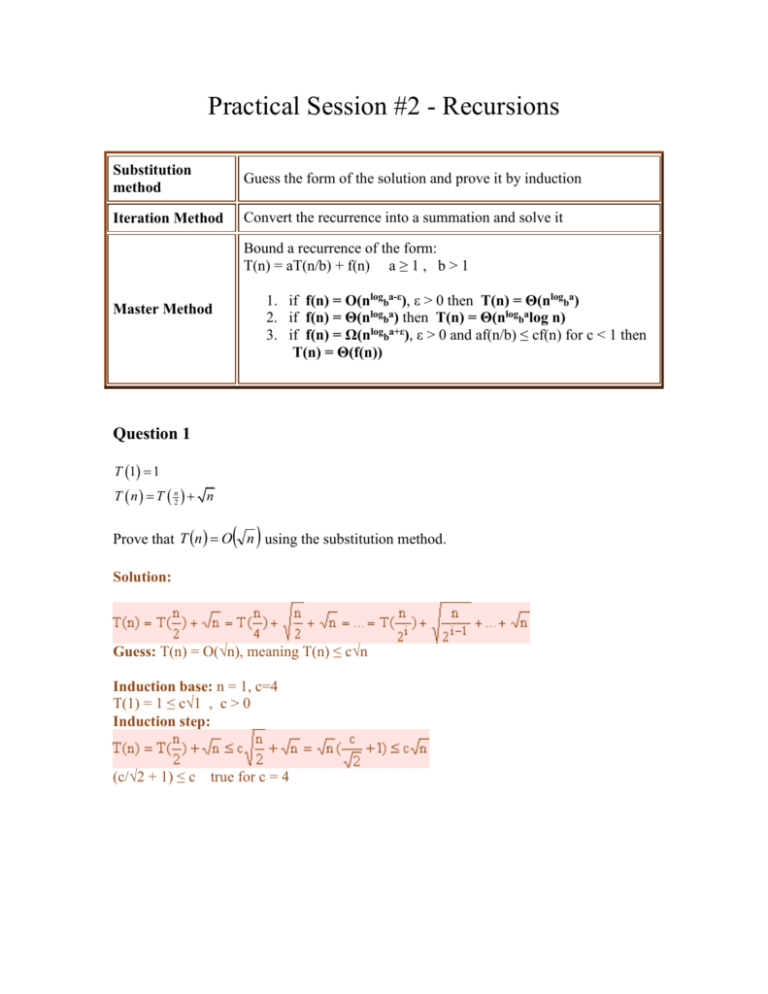
Practical Session #2 - Recursions
Substitution
method
Guess the form of the solution and prove it by induction
Iteration Method
Convert the recurrence into a summation and solve it
Bound a recurrence of the form:
T(n) = aT(n/b) + f(n) a ≥ 1 , b > 1
1. if f(n) = O(nlogba-ε), ε > 0 then T(n) = Θ(nlogba)
2. if f(n) = Θ(nlogba) then T(n) = Θ(nlogbalog n)
3. if f(n) = Ω(nlogba+ε), ε > 0 and af(n/b) ≤ cf(n) for c < 1 then
T(n) = Θ(f(n))
Master Method
Question 1
T 1 1
T n T n2 n
Prove that T n O n using the substitution method.
Solution:
Guess: T(n) = O(√n), meaning T(n) ≤ c√n
Induction base: n = 1, c=4
T(1) = 1 ≤ c√1 , c > 0
Induction step:
(c/√2 + 1) ≤ c true for c = 4
Question 2
T(a) = Θ(1)
T(n) = T(n-a) + T(a) + n
Find T(n) using the iteration method.
Solution:
T(n) = T(n-a) + T(a) + n
= [T(n-2a) + T(a) + (n-a)] + T(a) + n
= T(n-2a) + 2T(a) + 2n – a
=
[T(n-3a) + T(a) + (n-2a)] + 2T(a) + 2n – a
=
T(n-3a) + 3T(a) + 3n - 2a – a
=
[T(n-4a) + 4T(a) + (n - 3a)] + 3T(a) + 3n - 2a - a
=
T(n-4a) + 4T(a) + 4n - 3a - 2a – a
...
= T(n-ia) + iT(a) + in = T(n-ia) + iT(a) + in - ai(i-1)/2
After n/a steps, the iterations will stop.
Assign i = n/a:
T(n) = T(0) + (n/a)T(a) + n2/a – a(n/a - 1)(n/a)/2
= Θ(1) + (n/a)Θ(1) + n2/a – n2/2a + n/2
= Θ(1) + Θ(n) + n2/2a = Θ(n2)
T(n) = Θ(n2)
Question 3
Use the Master method to find T(n) = Θ(?) in each of the following cases:
a. T(n) = 7T(n/2) + n2
b. T(n) = 4T(n/2) + n2
c. T(n) = 2T(n/3) + n3
Solution:
a.
T(n) = 7T(n/2) + n2
a = 7, b = 2, f(n) = n2
nlog27 = n2.803..
n2 = O(nlog27 - ε) since n2 ≤ cn2.803..- ε ε, c > 0
T(n) = Θ(nlog27)
b.
T(n) = 4T(n/2) + n2
a = 4, b = 2, f(n) = n2
n2 = Θ(nlog24) = Θ(n2)
T(n) = Θ(nlog24log n) = Θ(n2log n)
c.
T(n) = 2T(n/3) + n3
a = 2, b = 3, f(n) = n3
nlog32 = n0.63..
n3 = Ω(nlog32 + ε) since n3 ≥ cn0.63..+ ε ε, c > 0
and 2f(n/3) = 2n3/27 ≤ cn3 for 2/27 < c < 1
T(n) = Θ(n3)
Question 4
Fibonacci series is defined as follows:
f(0) = 0
f(1) = 1
f(n) = f(n-1) + f(n-2)
Find an iterative algorithm and a recursive one for computing element number n in
Fibonacci series, Fibonacci(n).
Analyze the running-time of each algorithm.
Solution:
a. Recursive Computation:
recFib(n) {
if (n ≤ 1)
return n
else
return recFib(n-1) + recFib(n-2)
}
T(n) = T(n-1) + T(n-2)+1
2T(n-2) +1≤ T(n-1) + T(n-2)+1 ≤ 2T(n-1) +1
T(n) = O(2n)
T(n) = Ω(2n/2)
b. Iterative Computation:
Iterative computation:
IterFib (n) {
f[0] = 0;
f[1] = 1;
for ( i=2 ; i ≤ n ; i++)
f[i] = f[i-1] + f[i-2];
}
T(n) = O(n)
Question 5
Hanoi towers problem:
n disks are stacked on pole A. We should move them to pole B using pole C, keeping the
following constraints:
We can move a single disk at a time.
We can move only disks that are placed on the top of their pole.
A disk may be placed only on top of a larger disk, or on an empty pole.
Analyze the given solution for the Hanoi towers problem; how many moves are needed to
complete the task?
static void hanoi(int n, char a, char b, char c){
if(n == 1)
System.out.println("Move disk from " + a + " to "+ b +"\n");
else{
hanoi(n-1,a,c,b);
System.out.println("Move disk from " + a + " to "+ b +"\n");
hanoi(n-1,c,b,a);
}
T(n) = the number of moves needed in order to move n disks from tower A to tower B.
T(n-1)
Number of moves required in order to move n-1 disks from tower A to tower C
1
One move is needed in order to put the largest disk in tower B
T(n-1)
Number of moves required in order to move n-1 disks from tower C to tower B
T(1) = 1
T(n) = 2T(n-1) + 1
Iteration Method:
T(n) = 2T(n-1) + 1
= 4T(n-2) + 2 + 1
= 8T(n-3) + 22 + 2 + 1
...
after i = n-1 steps the iterations will stop
= 2*2n-1 – 1 = 2n – 1
T(n) = O(2n)
Question 6
T(1) = 1
T(n) = T(n-1) + 1/n
Solution:
As described in Cormen 3.9 (Approximation by Integrals), we can use an integral to
solve sums:
T n
1
n
1
n 1
1
n2
n
n
n
1 1 1 1x dx 1 ln n 1 1 ln n
i 1
1
i
i 2
n
1
i
1
Question 7
T(n) = 3T(n/2) + nlogn
Use the Master-Method to find T(n).
Solution:
a = 3, b = 2, f(n) = nlogn
nlogn = O(nlog23 - ε)
log 3
2 =1.585
nlogn ≤ cn1.5
logn < cn0.5
We may operate log on both sides (log is a monotonic increasing function and thus we
allows doing that):
Let us choose C=1:
Log(logn)<0.5logn
Clearly, log(x) is smaller then 0.5x, for x bigger then 4.
Hence we set n0 = 16.
T(n) = Θ(nlog23)
Question 8
Matrix multiplication
Given two n n matrix, A and B, give an efficient algorithm that computes its matrices
n
multiplication C=A∙B,
Cij Ai k Bkj .
k 1
Analyze the time complexity of this algorithm.
Solution:
First, let us explore the trivial solution. We may build an iterative algorithm as follows:
for i ← 1 to n
for j ← 1 to n
Cij ← 0
for k ← 1 to n
Cij ← Cij + Aik⋅ Bkj
This algorithm running time is clearly Θ(n3). However, is it the most efficient algorithm
we can find? Let us try another way of thinking, using the divide and conquer method.
We may regard each n n matrix as a 2 2 matrix of
n n
submatrices:
2 2
|
s a
|
b e
|
f
r
t
|
u c
|
d g
|
h
C
A
B
Now, in order to find r,s,t, and u , we shall make a simple 2 2 multiplication:
r =ae+bg , s =af +bh , t =ce+dg , u =cf +dh
n n
n n
submatrices, and 4 additions of
2 2
2 2
submatrices. While, matrix addition is a simple loop over all its elements, and thus can be
done in Θ(n2), the total running time of this algorithm is described by the recurrence:
This requires 8 multiplications of
T(n) = 8T(n/2) + Θ(n2).
This method is called Divide-and-Conquer:
Divide - split the problem into smaller problems
Conquer - solve the smaller problems
Merge - merge the smaller solutions into one solution
Which in our case would be:
n n
Divide: Partition A and B into ( ) submatrices. Form terms to be multiplied using +.
2 2
Conquer: Perform 8 multiplications of
Merge: Form C using + on
n n
submatrices recursively.
2 2
n n
submatrices.
2 2
Now, let us check this algorithm efficiency. The above recurrence can be solved
immediately using the master theorem:
n logb a n log2 8 n 3
Case 1 T(n)= Θ(n3).
And we can see that this is no better then the trivial algorithm!
Hence, we may add an improvement: we will try to multiply the two 2 2 matrices with
only 7 recursive multiplications instead of 8. This would be in the price of using more
additions and subtractions, which are already paid. This was Strassen’s idea:
We may define the following 7 matrices multiplication:
P1 = a ⋅ ( f – h)
P4 = d ⋅ (g – e)
P2 = (a + b) ⋅ h
P5 = (a + d) ⋅ (e + h)
P3 = (c + d) ⋅ e
P6 = (b – d) ⋅ (g + h)
P7 = (a – c) ⋅ (e + f )
Which we can use in order to find C submatrices r,s,t and u as follows:
r = P5 + P4 – P2 + P6
t = P3 + P 4
s = P1 + P2
u = P5 + P1 – P3 – P7
For example:
r = P5 + P4 – P2 + P6 = (a + d) (e + h)+ d (g – e) – (a + b) h+ (b – d) (g + h)=
= ae + ah + de + dh+ dg –de – ah – bh+ bg + bh – dg – dh =ae + bg.
Note that commutativity is not a property of matrix multiplication (A∙B≠B∙A), and thus
there is no reliance on it in this expression!
So, we managed to reduce 1 recursive multiplication. How more efficient can that be?
We may use again the master theorem to solve the improved algorithm recurrence:
T(n)=7T(n/2)+ Θ(n2)
n logb a n log2 7 n 2.81
Case 1 T(n)= Θ(nlog27).
The number 2.81 may not seem much smaller than 3, but because the difference is in the
exponent, the impact on running time is significant. In fact, Strassen’s algorithm beats the
trivial algorithm on today’s machines for n ≥ 30 or so.
